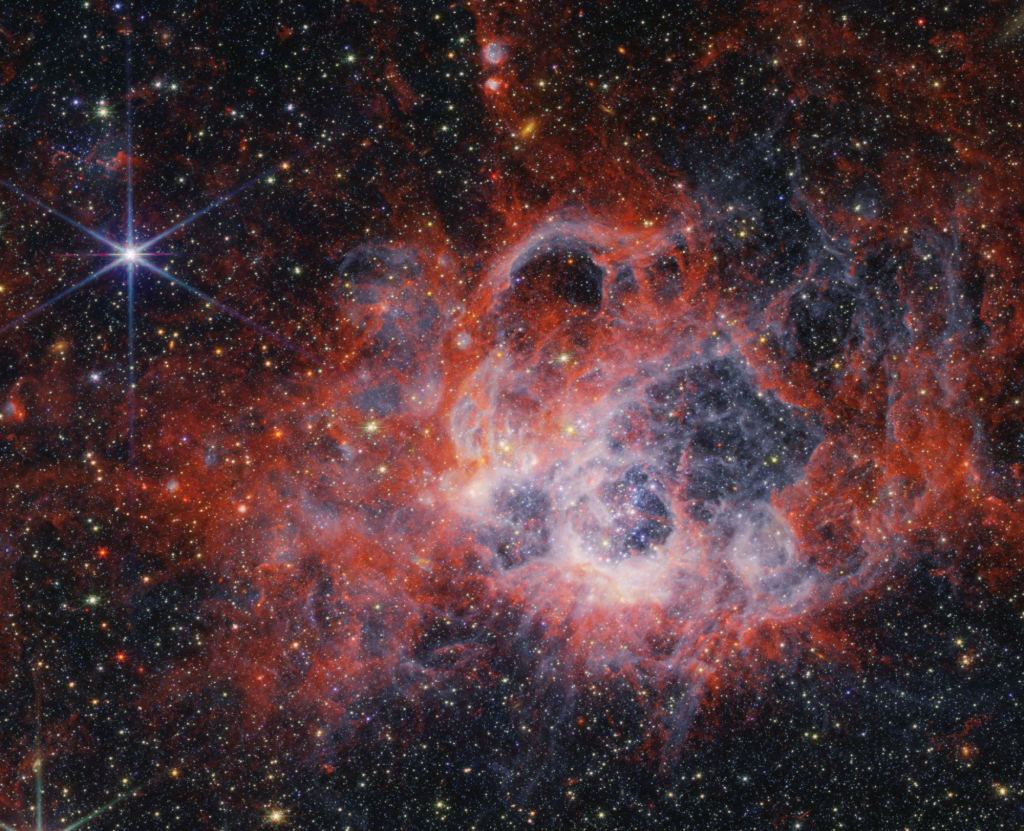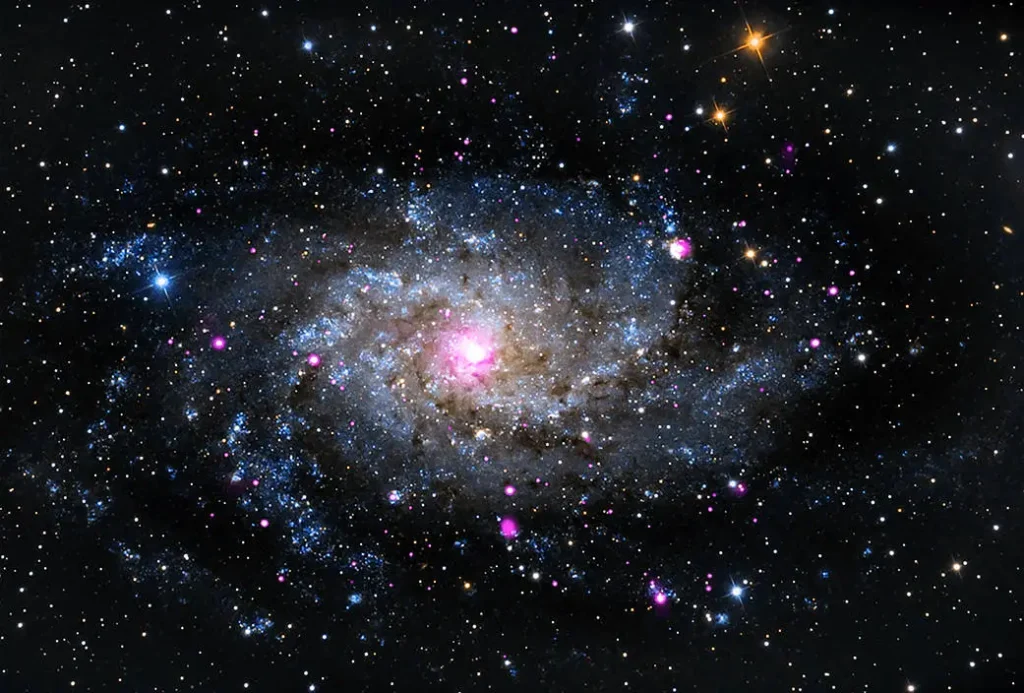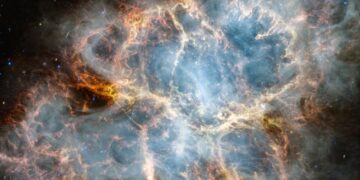The James Webb Space Telescope (JWST) has unveiled stunning images of supernova remnants (SNRs) in the Triangulum Galaxy (Messier 33), revealing unprecedented insights into the aftermath of these cosmic explosions. Through advanced infrared technology, JWST enables astronomers to observe SNRs in galaxies far beyond the Milky Way, where such studies were previously impossible due to technological limitations.
The Power of Infrared Observation in Astronomy
Infrared astronomy is central to exploring the universe beyond visible light, as it enables astronomers to study celestial phenomena hidden within cosmic dust clouds. The JWST’s Near-Infrared Camera (NIRCam) and Mid-Infrared Instrument (MIRI) are specially designed to capture light beyond the visible spectrum, offering an in-depth look at supernova remnants, nebulae, and more. Compared to previous instruments, JWST’s advanced infrared capabilities enable astronomers to see through the dense gas and dust where supernovae and their remnants reside, making it possible to study such distant objects in far greater detail than ever before.

Thanks to infrared observations, scientists can observe SNRs at near-to-mid (NIR-MIR) infrared wavelengths, revealing details about the atomic and molecular makeup of these remnants. This shift is crucial because it enables researchers to gather information not only about the structure of SNRs but also about the materials ejected by supernovae and how they interact with their surroundings. This knowledge sheds light on the complex physics of supernova explosions, which play a fundamental role in enriching galaxies with heavy elements.
Discovering Supernova Remnants in Messier 33

The recent JWST study of the Triangulum Galaxy has captured 43 supernova remnants in stunning detail, the first time these remnants have been observed so clearly beyond our local galactic neighborhood. The Triangulum Galaxy, located nearly 3 million light-years away, is home to numerous SNRs that astronomers have long wanted to study in infrared wavelengths. Dr. Sarbadhicary and his team strategically examined central and southern regions of Messier 33, gathering data through multi-wavelength observations.
This breakthrough is due to JWST’s improved spatial resolution, which makes it possible to distinguish supernova remnants even in crowded regions of distant galaxies. The telescope’s ability to resolve fine details allows astronomers to better understand the behavior of gas and dust in the vicinity of these explosions. Observing these remnants provides a window into how massive stars end their lives and contribute to the ongoing cycle of stellar formation and destruction.
The Role of Molecular Hydrogen in Supernova Remnants
Among the most exciting aspects of this discovery is JWST’s detection of molecular hydrogen in two of the SNRs in the Triangulum Galaxy. This molecule is generally dormant under typical interstellar conditions, but in SNRs, it becomes visible due to shock waves from supernova explosions. When the high-energy shock waves from a supernova interact with dense gas clouds, they generate heat, causing the molecular hydrogen to emit light in infrared wavelengths—a phenomenon detectable only with a highly sensitive infrared telescope like JWST.
The presence of molecular hydrogen serves as an indicator of high-energy interactions within SNRs. This process not only marks the locations of active shock waves but also helps scientists understand how supernovae influence their surrounding environments. Since star formation often occurs in dense molecular clouds, the interaction between supernova shocks and these clouds could play a role in initiating new stars.
Expanding Extragalactic Supernova Studies
Historically, studies of supernova remnants were limited to our galaxy and its satellite galaxies, such as the Magellanic Clouds, due to the technological constraints of previous infrared observatories. With the advent of JWST, astronomers can now expand these studies to distant galaxies, providing an entirely new field of extragalactic SNR research.
One of the key goals of expanding SNR studies is to gather more statistical data on the variety and behavior of supernova remnants across different galaxies. These remnants can vary greatly depending on factors such as the density of surrounding gas and the energy of the explosion. By studying SNRs in galaxies beyond the Local Group, scientists can better understand how supernovae impact galactic evolution on a larger scale.
Insights into Dust Formation and Destruction in SNRs
Supernova remnants are not only a source of high-energy radiation and shock waves but also a major contributor to cosmic dust. Dust plays a critical role in the formation of stars and planetary systems, acting as a building block for celestial bodies. However, dust within SNRs undergoes intense processes of formation and destruction, depending on the dynamics of the shock waves and the environment.
The presence of dust in SNRs contributes to the interstellar medium’s complexity, impacting everything from star formation rates to the chemical composition of the galaxy. By understanding the processes that govern dust creation and destruction within SNRs, scientists can piece together a more comprehensive picture of how galaxies evolve over time.
Comparative Studies with Other SNRs and Future Discoveries
The JWST’s ability to resolve SNRs in distant galaxies opens the door to comparative studies across a range of galaxies, including Andromeda and other Local Group galaxies. Each galaxy presents a unique environment, and by comparing SNRs in different galaxies, astronomers can identify patterns and anomalies that reveal the broader principles governing supernova behavior and impact.
In particular, astronomers are eager to study Cassiopeia A-type SNRs in other galaxies. These young, material-rich remnants offer an abundance of ejecta from the supernova explosion, providing a laboratory for studying the physics of extreme environments. JWST’s observations of such SNRs will enhance our understanding of galactic dust dynamics, star formation, and the lifecycle of elements within galaxies. Future studies with JWST could even identify new types of SNRs or rare phenomena that have yet to be observed in our galaxy, pushing the boundaries of our knowledge.
Implications for the Future of Astronomy
The JWST’s observations in the Triangulum Galaxy are only the beginning of a new era in extragalactic astronomy. By capturing detailed images of supernova remnants in galaxies far beyond the Milky Way, JWST enables astronomers to explore galactic evolution from an entirely new perspective. This data holds the potential to revolutionize our understanding of how galaxies evolve, how stars influence the interstellar medium, and how elements essential for life are distributed throughout the cosmos.
Beyond studying SNRs, the JWST’s capabilities will likely lead to groundbreaking discoveries across a range of astronomical phenomena, from the behavior of black holes to the formation of planetary systems. The telescope’s ability to observe faint and distant objects at multiple infrared wavelengths marks a major leap in our ability to explore the universe. As JWST continues to gather data, the scientific community anticipates a series of transformative discoveries that will reshape our view of the cosmos.
Conclusion: A New Frontier in Supernova Research
The James Webb Space Telescope has opened an exciting new chapter in the study of supernova remnants, providing a window into galaxies far beyond our own. By uncovering the details of SNRs in the Triangulum Galaxy, JWST offers insights into the life and death of stars, the formation of new stellar systems, and the cosmic dust that builds planets and sustains galaxies. This research is more than a technical achievement; it’s a step forward in humanity’s quest to understand the origins and dynamics of the universe.
Reference:
Sarbadhicary, S. K., Rosolowsky, E., Leroy, A. K., Williams, T. G., Koch, E. W., Peltonen, J., Smercina, A., Dalcanton, J. J., Glover, S. C. O., Lazzarini, M., Chown, R., Donovan Meyer, J., Sandstrom, K., Williams, B. F., & Tarantino, E. A first-look at spatially-resolved infrared supernova remnants in M33 with JWST



















